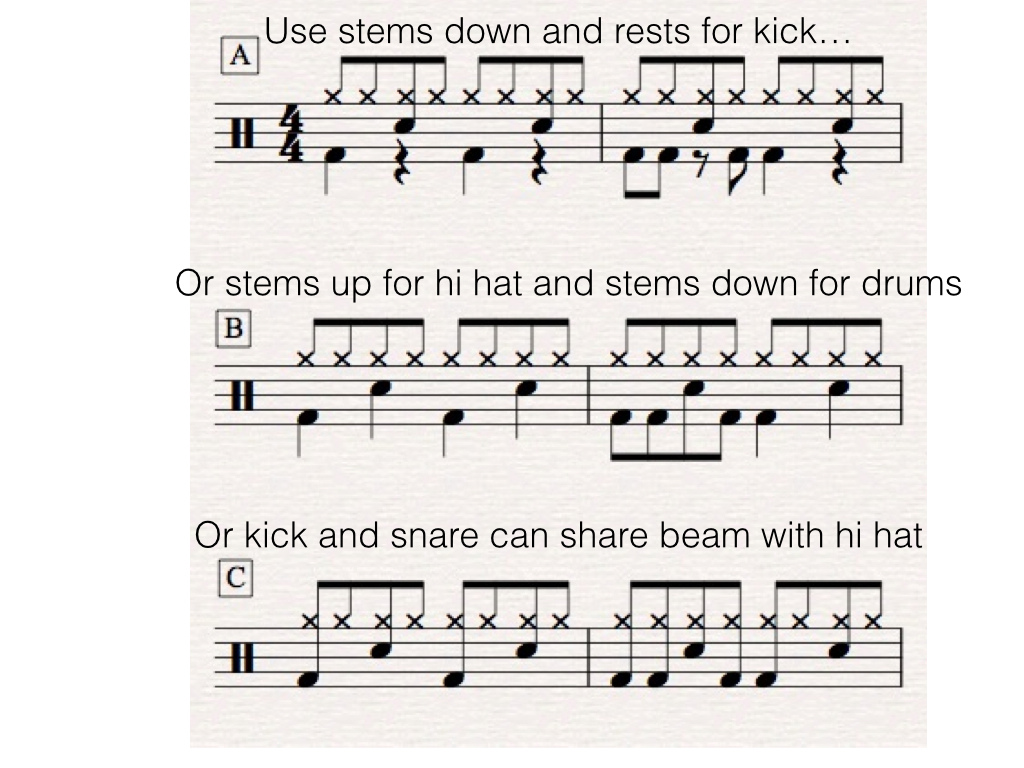
In this lesson you'll learn the basics of drumset notation. Notice the drum clef we use here, shaped like a rectangle on its side.
There is no universally agreed upon way to notate drums. The Percussive Arts Society recommends these note heads and locations, and uses a different shape for its percussion clef: two vertical lines.

Here are some different options for the direction of stems and the sharing of beams:

High hats can be open or closed. When they are open they are slightly apart and have more sizzle ringing after they are hit than when they are closed, which sounds more like a click. The opening and closing of the hi hats is controlled by the drummer's foot.
Let's do some dictation. Use these noteheads as a model. The kick drum is written on the first space from the bottom, the snare the third space, and the hi hat as an x on the space above the top line. One way to beam the hi hat eighth notes is by connecting beats 1 and 2 together, and beats 3 and 4 together:

Try notating the following one-bar pattern and then check your work. You will hear it played four times.
Dictation Example 1:
[ check your work ]
Try another. Here is a two-bar pattern played four times. Write down what you hear. Don't forget the percussion clef!
Dictation Example 2:
[ check your work ]
Notate what you hear in the next four examples of one-bar patterns and then check your answers.
Test Yourself Example 1
Test Yourself 2
Test Yourself 3
Test Yourself 4
[ check your work on Dictation Examples 1–4 ]
These next four are a little more complicated because they include sixteenth notes. Notice how the noes are grouped by quarter note—either two eighth notes or two sixteenths followed by an eighth.
Example:

Test Yourself Example 1
Test Yourself Example 2
Test Yourself Example 3
Test Yourself Example 4
[ check your work on Sixteenth Note Examples 1–4 ]
In this section you've seen how to notate drum patterns using common pitches for kick and snare drums and open and closed hi hat. If you have recording you may be able to sequence these patterns to be played on a virtual drum set.
Consider the technology you have at your disposal over the course of this class. Do you have a way to create a drum beat behind your chord, bass, and vocal parts to make a demo of your rock song?
[ Back to Overview ]

Listen again. Rewrite your transcription if there are any differences with the way it appears here. You can either beam the eighth notes in groups of two or four.
Dictation Example
[ return ]
Listen again. Rewrite your transcription if there are any differences with the way it appears here. Notice that rests are used in the snare drum part when there are no hi hat notes to share beams with.
Dictation Example 2
[ return ]
Four patterns with 8th notes: Dictation Examples 1-4

Did you get those all right? Listen again if you need to.
Test Yourself Example 1
Test Yourself Example 2
Test Yourself Eample 3
Test Yourself Example 4
[ return ]

Did you get those all right? Are you beats beamed together in the same way? Do the noteheads for the kick and snare share the same stems with the hi hat notes?
Listen again if you need to.
Test Yourself Example 1
Test Yourself 2
Test Yourself 3
Test Yourself 4
[ return ]